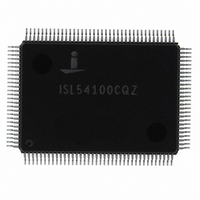ISL54100CQZ Intersil, ISL54100CQZ Datasheet - Page 14

ISL54100CQZ
Manufacturer Part Number
ISL54100CQZ
Description
IC REGENERATOR TMDS 4:1 128-MQFP
Manufacturer
Intersil
Datasheet
1.ISL54102CQZ.pdf
(21 pages)
Specifications of ISL54100CQZ
Applications
Multimedia Displays, Test Equipment
Interface
I²C
Voltage - Supply
3 V ~ 3.6 V
Package / Case
128-MQFP, 128-PQFP
Mounting Type
Surface Mount
Rohs Compliant
Yes
Lead Free Status / RoHS Status
Lead free / RoHS Compliant
Available stocks
Company
Part Number
Manufacturer
Quantity
Price
Company:
Part Number:
ISL54100CQZ
Manufacturer:
Intersil
Quantity:
128
Part Number:
ISL54100CQZ
Manufacturer:
INTERSIL
Quantity:
20 000
Power-down
The chip can be placed in a Power-down mode when not in
use to conserve power. Setting the Power-down bit (register
0x02 bit 5) to a 1 or pulling the PD input pin high places the
chip in a minimal power consumption mode, turning off all
TMDS outputs and disconnecting all TMDS inputs. Serial I/O
stays operational in PD mode. Note that the PD pin must be
low during power-on in order to initialize the I
Note: When exiting Power-down, a termination resistor
Recalibration cycle must be run to re-trim the termination
resistors (see register 0x03[7]).
Power Dissipation and Supply Current
Due to the large number of TMDS inputs and outputs, a
significant amount of current flows into and out of the
SL5410x. This makes calculating the total power dissipation
of the ISL5410x slightly more complicated than simply
multiplying the supply current by the supply voltage.
The supply current measurement includes the current
flowing through all the active TMDS termination resistors.
This current is supplied by the ISL54100's V
only 15% of it (0.5V*10mA per TMDS pair) is dissipated as
power inside the ISL54100. The majority of the power (2.8V
* 10mA per active TMDS pair) is dissipated in the TMDS
transmitter driving the ISL54100. Likewise, the ISL54100
dissipates 85% of the power generated by the current from
the external receiver attached to the ISL54100's Tx pins.
Any worst-case on-chip power dissipation calculation needs
to account for this.
Inter-Pair (Channel-to-Channel) Skew
The read pointers for Channel 0, 1, and 2 of the FIFO that
follows the CDR all have the same clock, so all 3 channels
transition within a few picoseconds of each other - there is
essentially no skew between the transitions of the three
channels.
However the FIFO read pointers may be positioned up to 2
bits apart relative to each other, introducing a random, fixed
channel-to-channel skew of skew of 1 or (much less
frequently) 2 bits. The random skew is introduced whenever
there is a discontinuity in the input signal (typically a video
mode change or a new mux channel selection). After the
CDRs and PLL lock, the skew is fixed until the next
discontinuity. This adds up to 2 bits of skew in addition to any
incoming skew, as shown in the following examples.
Figure 2 shows an input (the top three signals) with
essentially no skew. After the ISL5410x locks on to the
14
ISL54100, ISL54101, ISL54102
D
2
C interface.
supplies, but
signal, there may be 1 bit of skew on the output, as shown in
Figure 2.
When there is pre-existing skew on the input, the ISL5410x
can add up to 2 bits to the channel-to-channel skew. In the
example in Figure 3, the incoming red channel has 2.3 bits of
skew relative to the incoming green and blue. The FIFO’s
quantization (worst case) increases the total skew to 4.0 bits.
While increasing skew is not desirable, DVI and HDMI
receivers are required to have a minimum of 6 bits of inter-
pair skew tolerance, so the addition of 2 bits of skew is only a
problem with the most pathological cables and transmitters.
It does, however, limit the number of ISL5410xs that can be
put in series (although statistically it is unlikely that all the
skews would line up in a worst-case configuration).
OUTPUT SKEW
(1 bit – 615ps at
OUTPUT SKEW
162.5Mpixels/s)
162.5Mpixels/s)
(4 bits/2.5ns at
in this example)
INPUT SKEW
(2.3 bits/1.4ns
INPUT SKEW
(none, in this
FIGURE 2. MAXIMUM ADDITIONAL INTERCHANNEL SKEW
FIGURE 3. MAXIMUM ADDITIONAL INTERCHANNEL SKEW
example)
Bit 5
Bit 7
Bit 7
Bit 4
Bit 7
Bit 8
Bit 7
Bit 7
Bit 7
Bit 6
Bit 7
Bit 7
FOR INPUTS WITH NO OR LITTLE SKEW
FOR INPUTS WITH MODERATE TO LARGE
SKEW
Bit 4
Bit 3
Bit 7
Bit 6
Bit 6
Bit 6
Bit 5
Bit 6
Bit 6
Bit 6
Bit 6
Bit 6
Bit 3
Bit 4
Bit 5
Bit 5
Bit 2
Bit 5
Bit 6
Bit 5
Bit 5
Bit 5
Bit 5
Bit 5
Bit 2
Bit 3
Bit 4
Bit 4
Bit 1
Bit 4
Bit 5
Bit 4
Bit 4
Bit 4
Bit 4
Bit 4
Bit 1
Bit 0
Bit 4
Bit 3
Bit 3
Bit 3
Bit 2
Bit 3
Bit 3
Bit 3
Bit 3
Bit 3
Bit 0
Bit 2
Bit 2
Bit 2
Bit 1
Bit 2
Bit 2
Bit 2
Bit 2
Bit 9
Bit 2
Bit 3
Bit 9
Bit 8
Bit 0
Bit 2
Bit 1
Bit 1
Bit 1
Bit 1
Bit 1
Bit 1
Bit 1
Bit 1
Bit 8
Bit 0
Bit 0
Bit 0
Bit 9
Bit 0
Bit 0
Bit 0
Bit 0
Bit 7
Bit 0
Bit 1
Bit 7
Bit 9
Bit 9
Bit 9
Bit 8
Bit 9
Bit 9
Bit 9
Bit 9
Bit 6
Bit 9
Bit 0
June 4, 2008
FN6275.5
Bit 6
Bit 7
Bit 5
Bit 9
Bit 8
Bit 8
Bit 8
Bit 8
Bit 8
Bit 8
Bit 8
Bit 8
Bit
B
B
B
B
B
B
B
B
B
B
B












